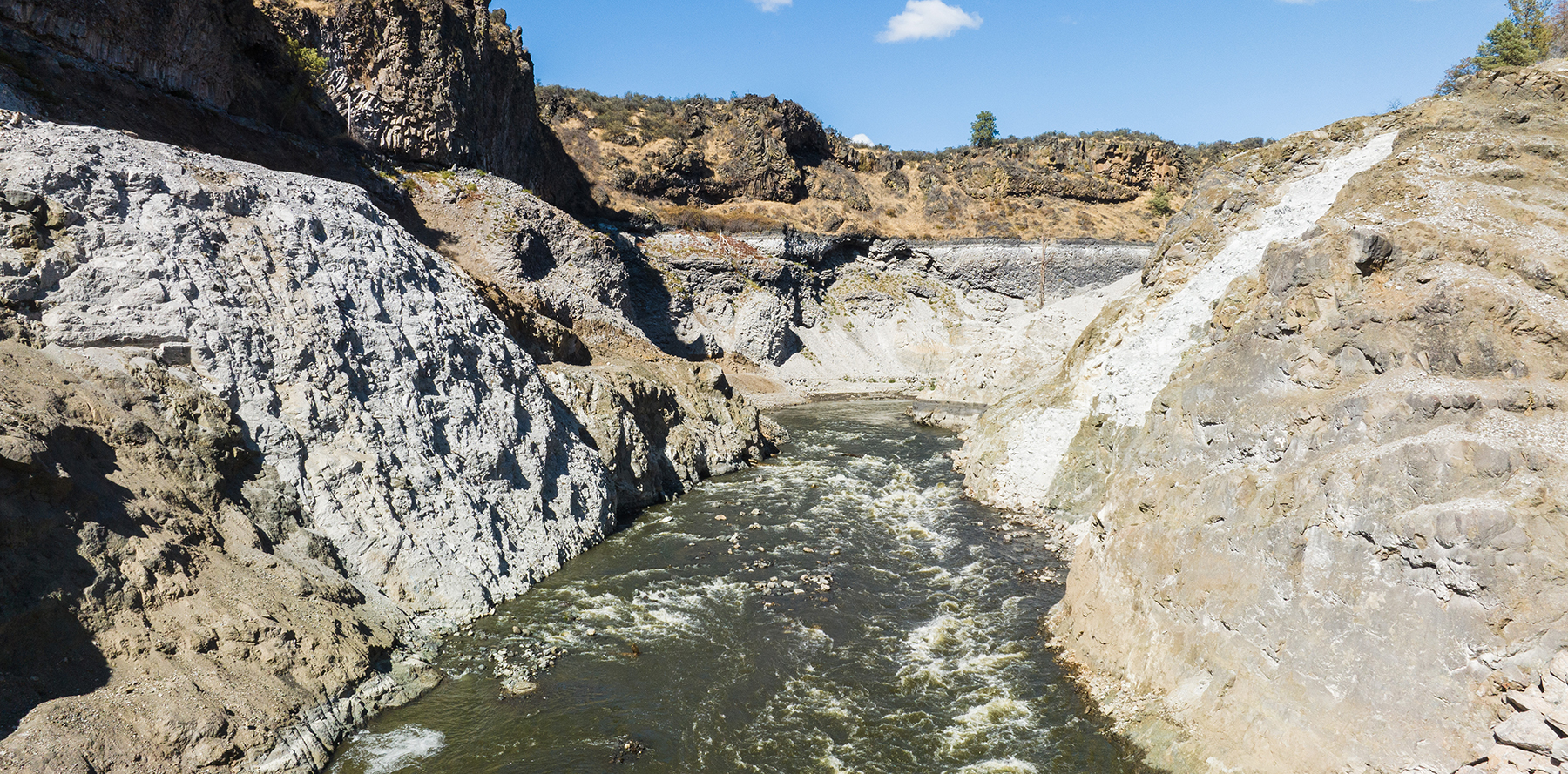

The Klamath River dam removal project – the largest such effort in U.S. history – produced positive results almost immediately.
The $500 million project dismantled four hydroelectric dams along the 257-mile Klamath River, which originates near Klamath Falls, Oregon, and flows to California’s North Coast, where it empties into the Pacific Ocean.
The dams, completed between 1918 and 1962, significantly altered the river’s natural flow for more than a century, preventing threatened and endangered salmon and steelhead trout from reaching their spawning grounds. Within 10 days of completing the final in-water work at Iron Gate Dam – an earthfill structure farthest downstream – more than 6,000 Chinook salmon were observed migrating upstream into newly accessible habitat over a two-week period, according to Mark Bransom, Ph.D., CEO of the Klamath River Renewal Corp., the nonprofit established to oversee the removal.
Further reading:
- Water infrastructure legislation passes, brings increased dam safety
- Construction begins on removal of 4 Klamath River dams
- Pittsburgh dams to be converted to ‘low-impact’ hydropower
“The fact that volitional fish passage was restored so quickly really speaks to the success of the project thus far,” Bransom said.
Moving upstream from Iron Gate, the three additional dams removed were Copco No. 2, a concrete diversion dam; Copco No. 1, a concrete gravity arch dam; and J.C. Boyle, a combination earthfill and concrete spillway dam. In addition to the now-dismantled system impeding fish spawning, the reservoirs slowed the river’s flow and warmed the water, creating conditions that fostered algae growth and degraded water quality.
Work was complete in early October, ahead of schedule and within budget. Kiewit, the prime contractor for the removal work, delivered the project via a progressive design-build delivery method. The project represents one of the most significant dam removals in the world, said Brian Graber, senior director of dam removal strategy at American Rivers, an organization that advocates for the health and protection of rivers.
“Never before have four dams of this size and scale been removed simultaneously,” Graber noted. “From an engineering perspective, they were not built for flood control or irrigation water – they were purely hydropower facilities. However, the hydropower they provided was so marginal that Oregon and California utilities recognized it was more cost-effective to remove them, ultimately contributing $200 million to the effort.”
Engineering preparations
A year of enabling construction work preceded the reservoir drawdowns and dam dismantling. These preparation activities represented some of the most challenging engineering and constructability aspects of the project, according to Bransom.
At Copco No. 1, Kiewit drilled and blasted a 10-foot-diameter tunnel about 100 feet through the base of the 125-foot-tall dam, stopping 12 feet short from the upstream dam face. To initiate the drawdown, the tunnel would later be extended through the remaining 12-foot section. The tunnel’s diameter size was based on a determined hydrologic condition that would help optimize sediment movement and the drawdown rate.

“Using long-term hydrologic records, we conducted extensive modeling around different hydrologic scenarios, including dry, average, and wet years,” Bransom said. “That helped us anticipate potential flow conditions from winter precipitation during the drawdown.”
Before the official drawdowns, the team conducted operational drawdowns to lower reservoir levels to their minimum operating pools. Copco No. 2 – the smallest dam – was completely removed in 2023 to ensure it would not impede sediment flow once Copco No. 1 and J.C. Boyle were dismantled.
Orchestrating the drawdowns
The drawdown sequence was carefully planned to manage flow and sediment through the hydroelectric reach. Iron Gate Dam was drained first. “As an earthfill dam, it was critical to provide sufficient storage capacity at Iron Gate to minimize overtop risk from a flood control perspective,” Bransom said.
About five days after beginning the Iron Gate drawdown, the team began draining J.C. Boyle, the uppermost dam. With its relatively small reservoir, J.C. Boyle was fully drained within 16 hours, merging its flow with the Copco No. 1 reservoir. Finally, the team blasted a 10-foot-diameter opening through the last 12 feet of the Copco No. 1 dam, fully opening the passage and commencing the final drawdown.
“Of course, the dimensions of both the tunnel at Copco No. 1 and the gate opening at Iron Gate were designed to contain the drawdowns and prevent overbank flows downriver,” Bransom said. “With several million cubic yards of sediment moving through the system, we needed to ensure the highly turbid water remained within the main channel.”
As the reservoirs drained and free-flowing river conditions were restored, the Klamath settled back into its previous path. “Bathymetric surveys revealed the river’s historic channel beneath the reservoirs, and from Iron Gate to the uppermost extent of the hydroelectric reach, the river returned to its original course despite decades of accumulated sediment,” Bransom said.
Dismantling the dams
In March 2024, deconstruction of the dams began, starting with Copco No. 1. Completed in 1918, Copco No. 1 was the oldest, and during its original construction, a railroad was built to deliver materials to the site. Part of the railroad was removed before the dam itself was constructed.
When the blasting crew members began drilling, they discovered rail steel embedded in the dam’s forms. “In many cases, it was just randomly placed or tossed in as reinforcing steel, even though it wasn’t necessarily tied in,” Bransom said. “Adjustments to the blasting regime were required to not only pulverize the concrete but also shear off the steel.”
Removal of the dam was done by drilling vertical holes 20-30 feet deep, depending on the lift being removed. “The crew drilled holes from the top of the dam down, packed them with explosive charges, and detonated them to break the dam into large concrete blocks,” Bransom explained.

The blocks were then further broken down using heavy equipment, and the concrete remnants were transported to a disposal site well above the river. The steel was separated and hauled off-site for recycling.
“Interestingly, Copco No. 1 was estimated to extend nearly 125 feet below the riverbed, matching its above-ground height,” Bransom noted. “Due to extensive fracturing and pockets in the basalt, large amounts of grout and concrete were used during construction to ensure a stable foundation. These materials were removed 15-20 feet below the river elevation as a precaution to prevent knickpoints or future barriers to fish passage.”
The deconstruction sequence continued with J.C. Boyle, followed by Iron Gate in June. Iron Gate’s removal involved roughly 1 million cubic yards of earth and clay-core material. “Above the dam site, on the left embankment, was the original borrow pit,” Bransom said. “Essentially, a portion of that hill was carved off to supply material for the dam’s construction. Approximately 800,000 cubic yards of material from Iron Gate were returned to that borrow pit and graded, re-creating a more natural landscape. The remaining 200,000 cubic yards were used to fill the emergency spillway.”

Sowing the seeds of recovery
With the deconstruction complete and the river flowing freely again, restoration efforts are underway along the Klamath’s tributaries and across 2,200 acres of land previously submerged by the reservoirs. Within the reservoir footprints, the primary focus is revegetation.
“We have accumulated on the order of 19 billion seeds from 98 native species of plants, shrubs, and trees that we are planting in those areas,” Bransom said. “The first round of seeding was a cover crop to stabilize sediments and improve soil composition. Our intent now is to establish long-term plant growth.”
For the tributaries, KRRC’s priorities include monitoring fish passage conditions, supporting habitat complexity, and enhancing the food web.
“We’re taking an adaptive management approach to the restoration,” Bransom said. “As the recovery and rebalancing takes hold, what can we do to enhance or speed those conditions along? That’s really our focus throughout 2025 and beyond.”
Graber emphasized the critical importance of removing the dams for the tribes that live along the river.
“It’s remarkable what they had to do to restore salmon populations that are so vital to their culture and food supply,” he said. “It took decades of protests and persistent efforts to make these removals a reality. Groups like ours provided supporting work, but the tribes were the heart and soul of the project.”



